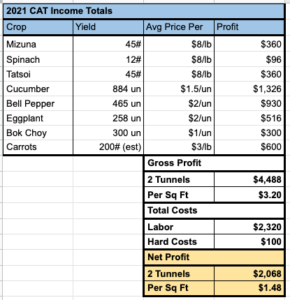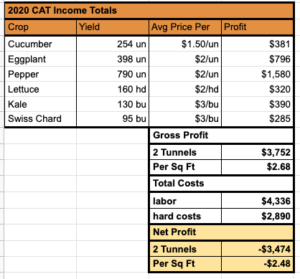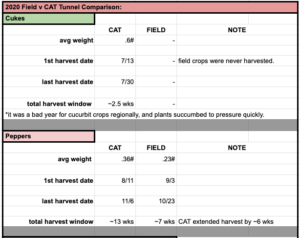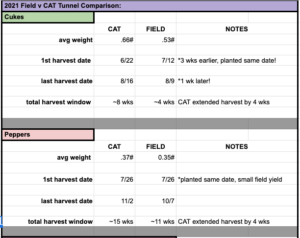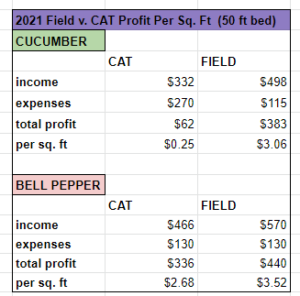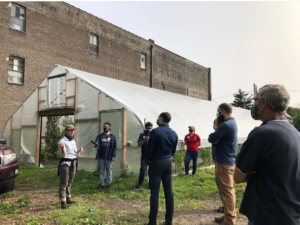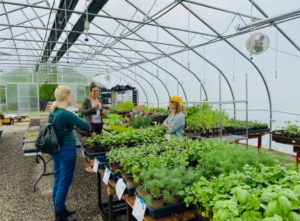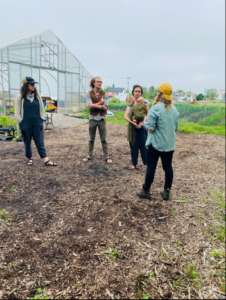Final report for FNE20-961
Project Information
To meet the growing demand for locally produced food year-round, many farmers have turned to protected agriculture for season extension. The 2017 Census of Agriculture reports approximately 10,849 farming operations growing under protected agriculture – a 24% increase from 2012. Of those operations, approximately 28%, roughly 3,000 farms, are located in the Northeast SARE region. Growers have numerous options ranging from high tunnels to low tunnels, greenhouses, and row covers, which all vary in price, labor to construct, stability, and return on investment. This project sought to explore the economic feasibility of caterpillar tunnels, an under-researched season extension option.
Caterpillar tunnels are three-season structures which are typically 6 to 8 feet high and 10 to 20 feet wide. They are usually held in place with ropes anchored to the ground. Ventilation must be managed manually. Unlike a more permanent option like high tunnels, they are often removed when not in use, are much less durable, and are much more portable. They are taller, more sturdy and offer more protected growing space than low tunnels, which are typically 2 to 3 feet high and cover the width of a growing bed. Like high tunnels, low tunnels and row cover, they protect cold-hardy crops in winter and spring plantings from cold and wind. Caterpillar tunnels represent a lower investment than high tunnels, and take up less space, making them a more feasible option for urban farms.
Caterpillar tunnels have been touted as having “the fastest possible payback period per initial investment of any growing structure”, despite there being no empirical evidence to support this claim. This study recorded all inputs and outputs involved in the production of cold hardy greens and two warm season crops in two caterpillar tunnels and compared them side-by-side to data collected from in-field production of the same crops. The goal of this project was to generate empirical data on the profitability of caterpillar production thus enabling growers to make better informed, science-based decisions when selecting season extension practices for their operations. Results of the project were disseminated through on-farm field days, published as a farmer-oriented article which was shared through various urban grower networks, and shared at two local conferences.
The project sought to determine the economic feasibility of caterpillar tunnel production in small-scale urban farming in the Northeast. More specifically, it sought to answer the question, Is the use of caterpillar tunnels economically beneficial for small-scale urban farmers? The objective was to determine whether the benefits and returns will outweigh the input, cost, and potential challenges associated with caterpillar tunnel management and production, and how quickly farmers should expect a return on investment. To answer this question, we measured all inputs and outputs of two caterpillar tunnels, and compared the yields of cucumbers and bell peppers in both caterpillar tunnels and in-field production in a side by side comparison over two seasons. The following is some additional information we gained throughout this project:
-How quickly might you see a return on your investment? (Break-even point).
-How do profits per sq ft compare in caterpillar tunnels v field production?
-Does caterpillar production result in higher yields and/or better quality of crops compared to in-field production?
-How, if at all, can profits be increased during shoulder seasons?
We believe this information to be useful for established farmers who have not yet invested in this type of equipment, as well as new farmers who are budgeting for planned projects.
According to the United Nations Department of Economic and Social Affairs, more than 55% of the world’s population lives in urban centers and in North America alone, more than 80% of the population resides in cities. Urban and peri-urban agriculture can help to increase sustainability and security of the local food supply and meet a growing consumer demand for locally produced foods. However, urban and small-scale growers, especially those in the Northeast where growing seasons are shorter, face unique challenges in meeting the demands of growing urban populations - one of the greatest being profitability.
As John Hendrickson stated in his report published by the Center for Integrated Agricultural Systems (CIAS), “Growing produce is not the biggest hurdle facing most fresh market vegetable growers; earning a reasonable living poses the greatest challenge.” He further concluded that keys to financial success for small-scale growers included utilizing techniques and tools to keep expenses low, in addition to the importance of implementing season extending techniques and technologies. This is especially true of farmers in the Northeast who experience colder climates which limits the growing season.
Varying forms of season extension have pros and cons, many of which have been explored by farmers and researchers alike. A substantial amount of research has been conducted on the economics and profitability of high tunnels, however high tunnels may be an expensive barrier to entry for urban and small-scale farmers who are looking to implement season extension on their farms. Furthermore, high tunnels occupy a lot of space and though movable high tunnel models exist, in practice, most are stationary. For urban and small-scale farmers who lack space and/or rent land, this may be yet another hindrance. For farmers who do utilize this method of protected culture, many prioritize growing high value crops, like tomatoes year after year without rotation. The permanence of the structure, paired with the lack of crop rotation, intensive fertilization, and frequent tillage lead to numerous soil health issues including compaction, reduced organic matter, high salts, and soil-borne diseases. Research conducted by Dave Waterer at the University of Saskatchewan has shown that though high tunnels can produce higher quality crops and higher yields, it can still take anywhere from 2-5 years to begin seeing profits. Too often high tunnels are poorly managed resulting in higher yields in the field than in the tunnels themselves. Low tunnels, often constructed with wire hoops and floating row cover, are relatively inexpensive, allow for mobility, and serve as a barrier to pests, but may not provide the same benefits as high tunnel production.
Caterpillar tunnels are marketed as an inexpensive, moderately stable/semi-permanent option. They are presented as tools that are inexpensive, easy to construct and cover, have excellent air flow, improve yield and quality of field-grown produce, and according to one source have the “fastest possible payback period per initial investment of any growing structure”. However, there is a lack of empirical data to support the economic feasibility of caterpillar tunnels in urban and small-scale production.
We proposed a two year study to determine the economic feasibility of caterpillar tunnel production as an alternative method of season extension on urban and small-scale farms. In order to assess the real economic benefit of implementing this type of protected culture on urban and small-scale farms, the study used the basic equation of Profit = Income - Expenses to determine the break-even point and profitability of caterpillar tunnel production. In the city of Buffalo, there are currently 25 urban and peri-urban farms in the region that are growing on land areas of 3 acres or less. 2017 Census data from Erie County reports that there is a total of 970 farms in the region, with 17%, or 165 farms, growing on 9 acres or less. An equal amount of farms reported practicing no-till or reduced till, and 28 are farming organically. Expanded at the state level, small farms of 9 acres or less make up 10% of the total, which equals roughly 3,350 farms, according to 2017 Profile of Agriculture from the NYS Comptroller. If caterpillar tunnels could be a means to reduce the barrier of entry for these urban and small-scale growers into season extension, we believe this information to be invaluable as it may help them to make better-informed, science-based decisions on which season extension techniques are the best fit for their operations.
Groundwork Market Garden is a 2 acre, USDA certified organic urban farm in Buffalo, NY. The farm has been engaged in diverse, intensive vegetable production since 2016. The farm currently serves its community year-round through both a summer and winter CSA; an on-site farmstand, and through area restaurants and institutions. The farm employs two year round employees, and one seasonal summer employee. Gross sales for 2021 were around $70,000. The farm has two 30x96' high tunnels, one heated 30x72' greenhouse, and makes use of low tunnel production in the shoulder seasons. This SARE project was the first experience with caterpillar tunnel production. A new field with 8 beds (2.5 x 50') was constructed for the placement of the caterpillar tunnels during this project. A previously owned BCS walk-behind tractor was used to initially shape the beds.
Cooperators
Research


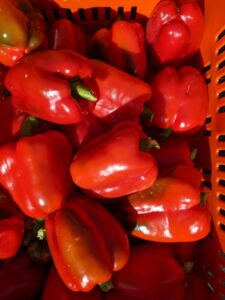
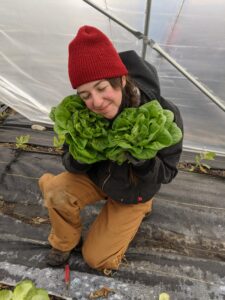
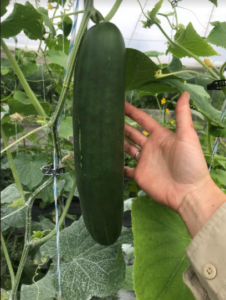
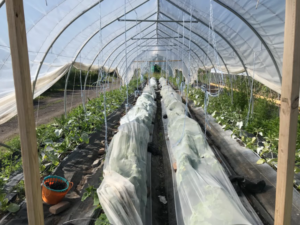
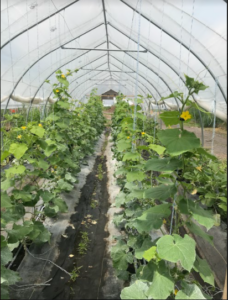
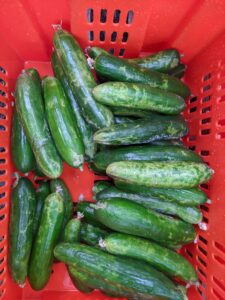
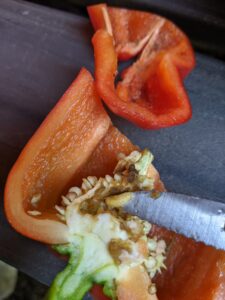
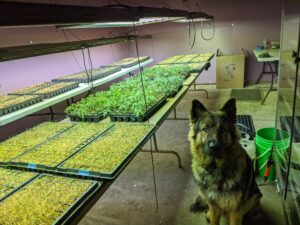
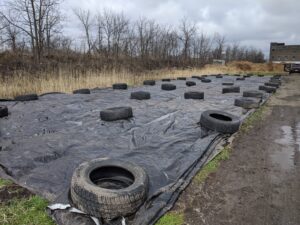
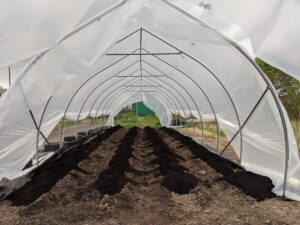
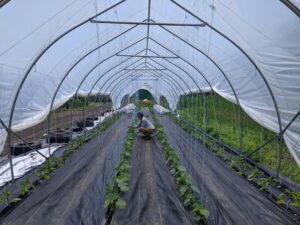
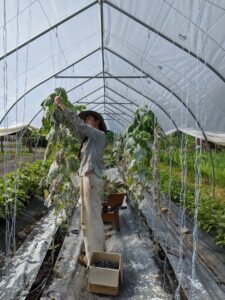
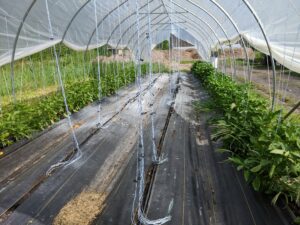
To determine the economic feasibility of growing in caterpillar tunnels, two different observations were studied over two growing seasons in 2020 and 2021. Records were kept of all time, labor, and resources (inputs) as compared to all yield, harvests, and profits (outputs) to determine the economic benefit and break-even point of caterpillar tunnels on urban and small-scale farms. The second compared the yield, harvest length (1st and last dates), and the average size of fruit for both cucumbers and bell peppers when grown in the caterpillar tunnels as compared to in-field controls.
During the first year of the project, two unheated gothic style caterpillar tunnel kits were purchased from Farmers Friend LLC that measured 14’ wide, 50 ft. long, with 5-ft bow spacing. Each tunnel was covered with 28-foot wide, 6 mil greenhouse plastic with a 4‑year rating.
The site for the caterpillar tunnels was covered with silage tarps for 5 weeks in early April 2020 to manage weed pressure on the site. On May 16th, the tarps were pulled off and the site was treated with black woven ground cover around where the perimeter of the structures would be to manage weed pressure and the two tunnels were framed and constructed. On May 21st, the plastic coverings for the tunnels were installed and four beds in each tunnel were formed.
For the length of the study, the in-field and caterpillar tunnel beds were standardized at 50 feet long, 2.5 feet wide. Both in-field and caterpillar tunnel beds were prepped with a broadfork and amended with compost and rock minerals before planting. Irrigation was laid with black woven ground cover and plastic drip tape with 12” drip spacing.
In both growing seasons, 100 red bell pepper seeds were sown into 50 cell trays containing a compost-based potting soil in early Spring. 3 weeks after, 100 red bell pepper seeds were seeded in the same manner for the in-field control. After 3 weeks in cell trays, the root balls of the bell peppers seedlings were inoculated and transplanted into 4” pots. The control transplants were potted up, in the same manner, several weeks later. The bell peppers were transplanted in a single row with 15” spacing in tunnels and in-field.
In 2020, in tunnels and in-field, the cucumbers were direct seeded at a 12” spacing at drip emitters. In 2021, the cucumbers were seeded in 50 cell trays containing a compost-based potting soil and planted at a 12” spacing at drip emitters.
The following data was recorded for all activity in the caterpillar tunnels throughout the duration of the project:
INPUTS:
Time
- spent on Planting, including:
- bed preparation
- fertilizer management
- seeding
- transplanting
- mechanical cultivation
- spent on Maintenance, including:
- watering
- weeding
- crop maintenance
- pest management
- hoop maintenance
- spent on Harvesting, including:
- packing
- washing
- harvesting
- spent constructing caterpillar tunnels
- spent setting constructing “in-field” beds
Cost of Production
- Cost of pest management
- Cost of water
- Cost of fertilization
- Cost of caterpillar tunnel
- Cost of labor
OUTPUTS:
Yields
- # of fruit
- Lbs. of marketable fruit (lbs were recorded with digital scale)
- Prices throughout the season
The inputs and outputs listed were recorded for all activities in the caterpillar tunnels over the two growing seasons. Additionally, throughout the duration of the project, the harvest length (1st and last dates), lbs of marketable fruit, prices throughout the season, and the average size of fruit for both cucumbers and bell peppers when grown in the caterpillar tunnels as compared to in-field controls.
2020:
Throughout the 2020 growing season, the first year of our two year study, we observed improved yields and lengthened harvest windows in our caterpillar tunnel when compared to our field trials, though overall yields and profits were greatly reduced due to pest and disease pressure, despite our best efforts to protect the crops. Pest and disease pressure was widespread throughout our WNY region, especially impacting the cucurbiteae family.
One advantage of planting the cucumbers in the caterpillar tunnels was an earlier planting date than our in-field controls, which allowed them to produce some fruit before they succumbed to cucumber beetle and downy mildew pressures, though yields were dramatically lower than in previous growing seasons and what we had anticipated. The in-field cucumber trials were never able to produce fruit before succumbing to pest and disease pressure.
Pepper plants were large and healthy, though they were later producing fruit and we think this may be due to high temperatures in the caterpillar tunnels. Once temperatures cooled in the fall, production increased and we harvested well into October while the in-field peppers had already been hit by frost. We did have pest pressure in the pepper plants as well which reduced the amount of marketable fruit.
Late season lettuce was planted in the caterpillar tunnel, which resulted in earlier and larger yields when compared to the in-field trials. Heads were larger in size and earlier to harvest. This was promising and we anticipate using the caterpillar tunnels for early spring plantings in the second season of our trials now that they are constructed.
Final:
- In both 2020 & 2021 trials, there were earlier and longer harvests in both cucumbers and peppers, extending the harvest season by 4-6 weeks, which is significant.
- The CAT tunnels allowed for some harvest of cukes before disease entered region with earlier planting in 2020.
- Bell peppers did significantly better in 2020 in CAT compared to field trials, which contrasts with 2021
- In 2021, a DMR cucumber was used, which may have helped overall yields and outcomes.
- Considering irrigation v rain, much more time is spent watering in CAT.
- The beds used for field production have been amended over several years, v. new beds in CAT tunnels, which meant better soil conditions in-field.
- We observed a large difference in labor hours for trellising/pruning cukes in CAT v in-field.
- We did not reach a break-even point over the course of the 2-year study, but we anticipate that we will break even and see significant profits from the structures in 2022.
- Profits (income-expenses) per square foot were calculated for cucumber & bell pepper crops grown in the caterpillar tunnels and in-field. Data from 2021 was used to keep out labor & hard costs associated with building new beds & tunnels. The data reveals that crops grown in the caterpillar tunnels yielded less and required more inputs (labor) and therefore resulted in less profit per square foot when compared to in-field production for both cucumbers and bell peppers in 2021.
The amount of inputs that went into the caterpillar tunnels in the first year trial were far greater than the outputs. Some of this was to be expected, as cost of the tunnel materials and labor for construction and bed preparation are exclusive to year one and factor heavily in the equation. Given the low yields in the tunnels due to pest and disease issues, the outputs were heavily effected and we have not seen profitability or a break-even point with the tunnels.
Considering the space constraints associated with urban and small-scale farms and given that many small farmers might lack access to capital necessary for larger investments such as a high tunnel, caterpillar tunnels may be a potential point-of-entry for farmers looking to extend theirs growing seasons, given their relatively low cost.
The break-even point for farmers will vary from farm to farm depending on several factors including site considerations, crops grown, pest/disease issues, farmer learning curve, and varying labor costs. On our farm, after two seasons, we have not seen a break-even point, but predict that we will break even and see considerable profits in year three.
Although we did not record a significant difference in size/quality of crops in CAT tunnels v field production in this study, we were able to see larger yields over an extended harvest period for both cucumbers and bell peppers in the CAT tunnels v our in-field controls.
When you consider the potential for extending the shoulder seasons and lengthening harvest windows, as demonstrated through this study, the potential profits per square foot in caterpillar tunnels v. in-field production is significant.
Education & outreach activities and participation summary
Participation summary:
In 2020, over 25 participants of an urban agriculture tour came to our site to tour the farm on September 14th. The participants visited the caterpillar tunnels and were briefed on the ongoing trials and our findings thus far. The interest in this study has since resulted in a number of urban farmers reaching out to ask questions about our experiences with caterpillar tunnels as a season extension tool. Mayda Pozantides, farmer, also presented at NOFA-NY's Winter Conference in January 2021 and spoke for several minutes about the SARE Farmer Grant and the research being conducted at the farm, with an estimated 60 participants.
In 2021, there were several tour groups that came through the farm, as well as a series of weekly open-house style tours in June, where participants were briefed on the study and visited the site. The following are a list of dates that tours were given on the farm. We estimate the total number of attendees to be around 150.
May 28
June 3
June 7
June 10
June 24
August 28
A grower-oriented article was created and disseminated to the Greater Buffalo Urban Growers network, which includes over 25 urban agriculture organizations, including one organization that includes over 100 community gardens in its network. The article is also set to be disseminated through the Cornell Cooperative Extension's Urban Agriculture Program Newsletter, and has been sent to CCE Erie County, Cornell Small Farms Program, and NOFA-NY to be shared through their networks and newsletters. Pozantides again presented at NOFA-NY's 2021 Winter Conference where she spoke about the SARE Farmer Grant and research project and shared the grower-oriented article with the participants.
Economic Feasibility of Caterpillar Tunnels on Urban & Small-scale Farms
Learning Outcomes
The growers involved in the study have reported increased knowledge of methods and best practices with regards to season extension and protected culture production methods, tunnel management, and and increased awareness of how best to maximize profits with regards to caterpillar tunnel production. The growers have an increased awareness of the benefits and challenges associated with season extension and caterpillar tunnel production. The knowledge gained through the study will help these growers to make informed decision when considering overall farm profitability and season extension production. Though we do not have reports from the many growers that were reached with the dissemination of information through tours, presentations and articles, we expect that the information provided will be beneficial for new and existing small-scale and urban growers to make informed who have not yet invested in this type of equipment, as well as those who may be budgeting for planned projects, and will help them to make more informed decisions.
Project Outcomes
The study and its impact are far-reaching, not only for our farm and the growers there but also for small-scale and urban growers in Buffalo, New York State, and potentially the whole Northeast. For our farm, it allowed us to gain an understanding of the true cost of production for a variety of crops, learn and implement best practices with regards to tunnel production, and share that information with our staff. We were able to significantly extend our season, increasing profits in the shoulder seasons and even began a winter CSA in 2021 as a result of the increase ability to grow into the late fall with protected culture. In addition, two farms in our area were able to make informed decisions based on the information we shared with them, which resulted in both farms purchasing and implementing caterpillar production on their farms. The information that was shared through the duration of this project, through our grower-oriented article and tours/presentations has reached a widespread audience of growers of varying experience throughout Buffalo and NYS.
There was a definite learning curve with managing these structures and knowing how to maximize profits. As with all structures, it is necessary to consider the location/soil quality/drainage of the construction site. Due to lack of options and space on our small urban farm, we had to create a new field which didn’t have the best soil or drainage, and our outcomes were affected. It would be interesting to do a similar study of cat tunnels when compared to low tunnels. It seems that the real benefit and profits of the cat tunnels on our farm were seen with greens in the shoulder seasons. Low tunnels might produce similar results and would save on hard costs and labor, and a study comparing the two methods would be interesting information to have. Additional steps could be taken to mitigate issues such as temp/pest control, such as purchasing insect netting to put around the structure and shade cloth for summer heat, but that would also mean an increase in costs, inputs, & labor. We may have been able to save on initial investment costs by applying for a NRCS EQIP grant which now allows for the use of caterpillar tunnels. Having volunteers help with construction, instead of paid employees, could greatly reduce labor-associated costs. We will continue the use of caterpillar tunnels on our farm as a way to extend the shoulder seasons and increase profitability. High value greens will be our main crop grown in the tunnels during the shoulder seasons. In the coming summer, we are going to grow cherry tomatoes and see how the profitability compares with cucumbers and bell peppers.
